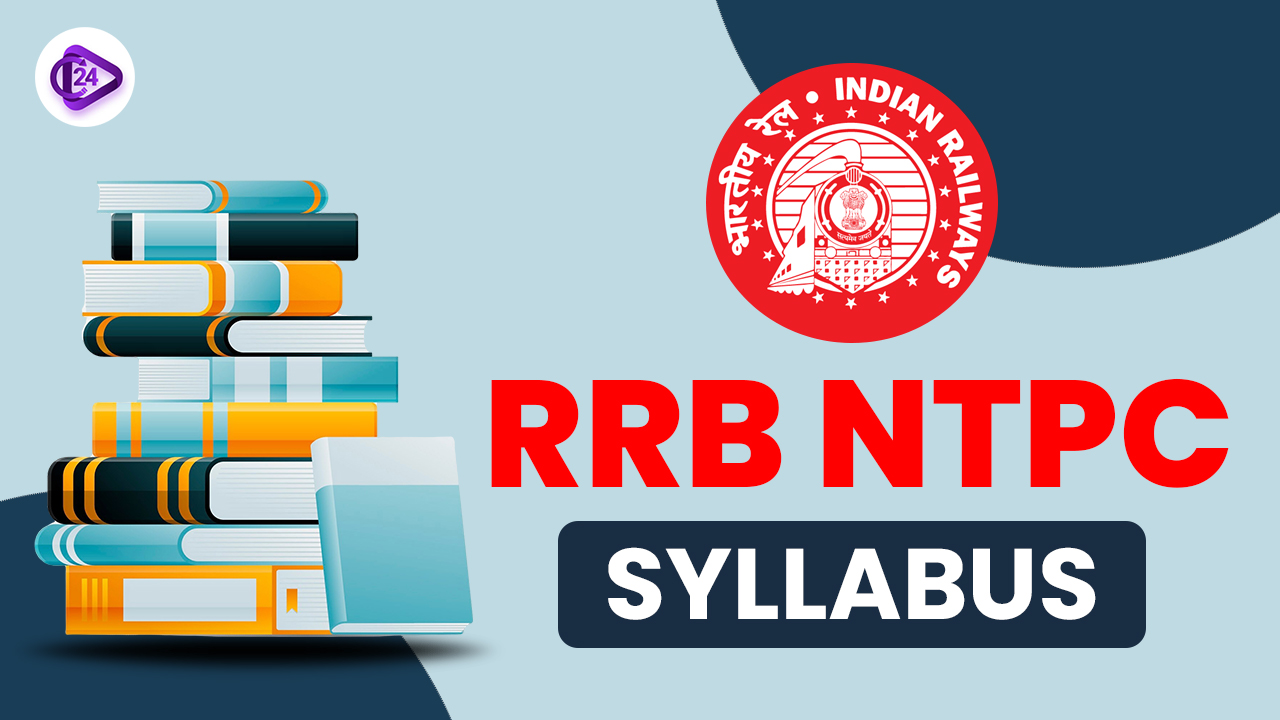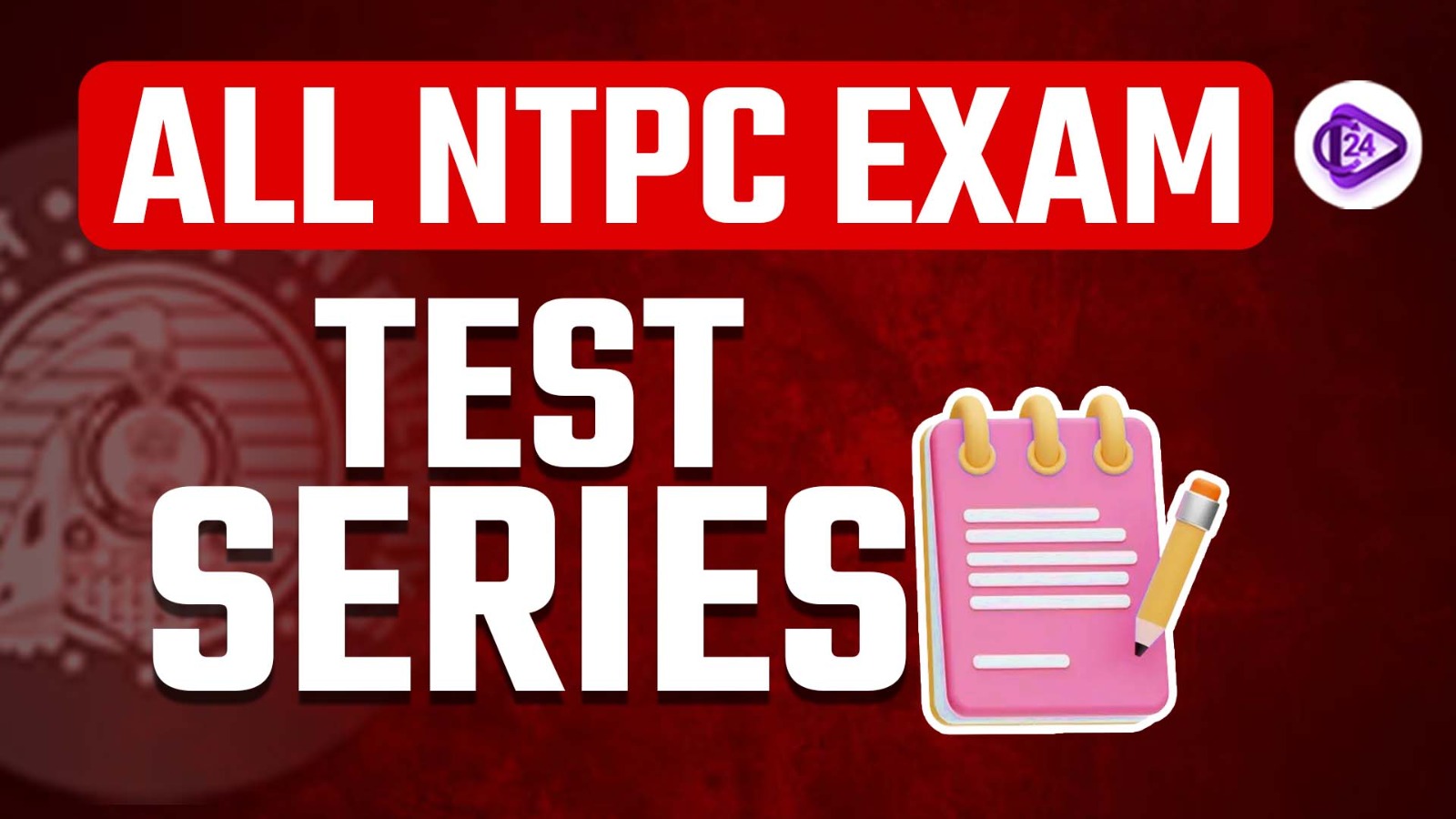The Railway Recruitment Board has now published the CBT-1 examination schedule for graduate candidates applying for the Non-Technical Popular Categories in 2025. Candidates preparing for CBT-1 will take their exams from 5th June to 23rd June 2025, following the announcement on 13th May 2025. With this recruitment campaign, applicants have a strong chance to find graduate-level jobs in the railways, like Station Master, Goods Guard and Junior Account Assistant cum Typist.

Studying the RRB NTPC Syllabus 2025 is necessary for those hoping to achieve their best in the examination. The course content for CBT-1 and CBT-2 contains Mathematics, General Intelligence & Reasoning and General Awareness. The areas covered do not change between the stages, although CBT-1 has fewer and less complex questions than CBT-2 which all must be completed within 90 minutes . This blog describes the important topics, tests and learning techniques for each subject to assist candidates in organizing their studies.
RRB NTPC Syllabus 2025: Overview
The RRB conducts the NTPC (Non-Technical Popular Categories) exam to hire people for different graduate and undergraduate jobs in the Indian Railways. These posts are called Station Master, Goods Guard, Junior Clerk cum Typist, Commercial Apprentice and additional types. CBT 1, CBT 2, Typing Skill Test/Computer Based Aptitude Test (as needed) and Document Verification are each parts of the selection process. Mathematics, General Awareness and General Intelligence & Reasoning are the topics that the exam assesses through online testing. Getting to know the details of the structure and process is key for making better strategies.The RRB NTPC 2025 examination consists of these elements according to the defined pattern and syllabus as outlined below;
RRB NTPC Syllabus 2025 Overview
| Feature | Details |
|---|---|
| Exam Name | RRB NTPC (Non-Technical Popular Categories) |
| Conducting Body | Railway Recruitment Board (RRB) |
| Posts Offered | Station Master, Goods Guard, Junior Clerk, Typist, Traffic Assistant, etc. |
| Exam Levels | Undergraduate & Graduate Posts |
| Selection Process | CBT 1 → CBT 2 → Typing Skill Test / CBAT (if applicable) → Document Verification |
| Exam Mode | Online (Computer-Based Test) |
| Job Location | All over India (Zonal Railways) |
| Official Website | www.rrbcdg.gov.in |
RRB NTPC 2025 Syllabus PDF Download
Having the official syllabus in PDF documents will greatly help you organize your studies for the RRB NTPC 2025 exams. The syllabus explains the subjects for CBT 1 and CBT 2, making sure you pay attention to the appropriate things. The syllabus includes Mathematics, General Intelligence & Reasoning, and General Awareness. After downloading the syllabus, you have the structure to plan your studies, see how you are doing and meet what the course expects. The official RRB NTPC 2025 syllabus PDF can be downloaded easily from this website:
RRB NTPC Syllabus 2025: CBT 1
The RRB NTPC examination syllabus is the same in CBT 1 and CBT 2; however, the pattern of examination differs, wherein the number of questions and the respective marks differ in the two phases. The total number of questions to be asked in the entire RRB NTPC CBT 1 will be 100 in total. In CBT 2, there will be 120 objective-type questions with multiple-choice answers, just like in CBT 1. Below is the comprehensive RRB NTPC CBT 1 and CBT 2 examination syllabus. CBT The questions are most likely to be of objective-type multiple-choice questions:
RRB NTPC Mathematics Syllabus 2025
The 2025 RRB NTPC Mathematics section exists to evaluate trainees on their aptitude for numbers alongside their abilities to craft solutions to problems. The assessment section tests candidates' understanding of multiple mathematical concepts needed to efficiently solve practical issues. This section contains the complete list of subjects which follows.
| Section | Topic | Definition |
| Simplification | BODMAS Rule | Order of operations: Brackets, Orders (powers and roots), Division, Multiplication, Addition, Subtraction. |
| Fractions | Numbers representing parts of a whole, written as a ratio of two integers. | |
| Approximate Value | Estimating a number to the nearest value for simplicity. | |
| Surds & Indices | Surds: Irrational numbers expressed with roots; Indices: Powers of numbers. | |
| Interest | Simple Interest | Interest is calculated only on the principal amount. |
| Compound Interest | Interest is calculated on the principal and also on previously accumulated interest. | |
| Installments | Payments made in parts over time. | |
| Percentage | Basic Percentage Problems | Calculations involving percentage increase, decrease, or comparisons. |
| Ratio & Proportion | Simple Ratios | Comparison of two quantities. |
| Compound Ratio | Ratios involving more than two quantities. | |
| Direct/Indirect Proportions | Direct: One quantity increases as another increases. Indirect: One quantity decreases as another increases. | |
| Average | Problems on Average | Calculations involving the mean of a set of numbers. |
| Problems on Weight/Height/Marks/Ages | Average-related problems involving different physical or academic measures. | |
| Speed, Time & Distance | Problems with Average Speed | Average speed calculated from total distance and total time. |
| Problems with Relative Speeds Problems on Boats, Trains, etc. |
Speed, time, and distance problems involving vehicles. |
|
| Algebra | Basic Linear Equation in One Variable | Equations involving a single variable in the form of ax + b = c. |
| Basic Linear Equation in Two Variables | Equations involving two variables in the form of ax + by = c. | |
| Profit & Loss | Problems with Profit/Loss | Calculations involving gains or losses from transactions. |
| Dishonest/Successive Dealings | Problems involving fraud or multiple transactions affecting profit/loss. | |
| Partnerships | Calculations involving profit-sharing among partners. | |
| Number Series | Complete the Series | Identifying and continuing a sequence of numbers. |
| Finding Missing/Wrong Term |
RRB NTPC General Intelligence & Reasoning Syllabus 2025
The 2025 RRB NTPC General Intelligence & Reasoning curated syllabus exists to evaluate how well candidates can solve logical problems and analyze situations. The core section consists of fundamental reasoning skills tests that form an essential component of both CBT 1 and CBT 2 exams. Following is a complete structure of topics addressed in this section.
| Section | Topic | Definition |
| Classification | Number | Identifying the category or class to which a number belongs. |
| Letter & Meaningful Words | Sorting letters or words based on their meaning or category. | |
| GK Based Questions | General knowledge questions related to classification. | |
| Analogy | Number | Finding the common in numerical couples |
| General Knowledge | Establishing a relationship between objects of general knowledge | |
| Meaning & Letter-Based Questions | Finding relationships between letters or their meanings | |
| Series | Number & Alphabet Series | Letters or numbers to identify - patterns or correspondence |
| Coding-Decoding | Letter Shifting | Encoding by the use of switching alphabetic letters |
| Coding Letters by Words | Encoding letters based on word patterns. | |
| Coding by Analogy | Encoding letters or numbers by finding analogous patterns. | |
| Coding-Decoding Based on Numbers | Encoding or decoding numbers based on specific rules. | |
| Operations on Place Value | Encoding or decoding using place values in numbers. | |
| Coding & Decoding on Fictitious Language | Using fictional or constructed languages for encoding/decoding. | |
| Blood Relations | Family Tree Problems | Solving problems related to relationships within a family tree. |
| General Blood Relation Problems | Identifying relationships between family members based on given data. | |
| Clock & Calendar | Calendar-Based Questions | Problems related to dates, days of the week, and calendar calculations. |
| Questions on Time & Clock Hands | Calculations involving the positions of clock hands and time. | |
| Ordering & Ranking | Simple Ranking Questions | Arranging individuals or items based on ranking or order. |
| Directions & Distances | Simple Problems with Directions | Solving problems involving cardinal directions and paths. |
| Formula-Based Distance Question | Calculations based on fixed formulas related to distances and directions. | |
| Word Formation | Arranging Words in a Meaningful Order | Forming meaningful words or sentences from given letters. |
| Non-Verbal Reasoning | Complete the Pattern | Identifying and completing patterns in figures or shapes. |
| Figure-Based Analogy | Recognizing relationships between different figures. | |
| Classification | Sorting or classifying figures based on their attributes. | |
| Series | Identifying sequences in patterns or figures. | |
| Cube-Based Questions | Solving problems involving 3D figures and cube rotations. | |
| Others | Missing Number | Finding missing numbers in sequences or patterns. |
| Venn Diagram | Solving problems using Venn diagrams to show relationships between sets. | |
| Puzzle | Solving various types of puzzles involving logical reasoning. |
RRB NTPC General Awareness Syllabus 2025
The RRB NTPC General Awareness syllabus for 2025 evaluates candidates by testing their knowledge of current affairs together with history, geography, economics, and general science subjects. The evaluation of applicant knowledge and their practical application abilities in real-life situations is the vital focus of this portion for selection. The following details all subject areas within this section.
| Section | Topics to Prepare |
| Current Affairs/General Awareness |
|
| General Science |
|
RRB NTPC Subject-wise Syllabus 2025: CBT 2
The CBT 2 Exam consists of three areas as well: general awareness, mathematics, and general intelligence and reasoning. View the CBT 2 subject-by-subject syllabus below.
1. Mathematics
The 2025 RRB NTPC Mathematics Syllabus information is available for candidates to review.
- Number System: Decimals, Fractions, LCM, HCF
- Algebra: Linear Equations, Polynomials
- Ratio and Proportion: Basic Ratios, Proportions
- Percentage: Profit/Loss, Simple/Compound Interest
- Mensuration: Areas and Volumes
- Time and Work: Efficiency, Wages
- Time and Distance: Speed, Relative Speed
- Data Interpretation: Tables, Graphs
2. General Intelligence and Reasoning
The General Intelligence & Reasoning Syllabus for RRB NTPC's CBT 2 syllabus
- Analogies: Number, Alphabetical, Word
- Series: Number and Alphabet Series
- Coding-Decoding: Letter and Number-Based
- Syllogism: Logical Conclusions
- Puzzle: Arrangement, Sequence
- Blood Relations: Family Trees
- Direction Sense: Relative Directions, Distances
- Data Sufficiency: Logical Reasoning
3. General Awareness
The general awareness syllabus for CBT 2 and CBT 1 differs in difficulty, but otherwise, they are nearly identical. Examine the table for the General Awareness CBT 2 Syllabus.
- Current Affairs: National and International
- History: Ancient, Medieval, Modern India
- Geography: Physical, Social, Economic
- Polity: Indian Constitution, Governance
- Economics: Basics and Recent Developments
- General Science: Physics, Chemistry, Biology
- Culture: Art, Literature, Monuments
RRB NPTC Subject-wise Weightage
Topic Wise Weightage for General Intelligence Reasoning
The table below indicates topic-wise mark distribution for General Intelligence and Reasoning –
|
Topics |
Weightage |
|
Decision making |
1-2 |
|
Coding-Decoding |
3-4 |
|
Puzzles |
3 |
|
Analogy |
2 |
|
Order and Rank |
2-3 |
|
Alphabet & Figure Series |
2-3 |
|
Blood relation |
1-3 |
|
Odd pair |
1-2 |
|
Logical Arrangement of words |
3 |
|
Distance & Direction |
2-3 |
|
Venn diagram |
3-4 |
|
Number series |
2 |
|
Odd One Out |
1 |
|
Mathematical operators |
1-2 |
|
Statement & Conclusions |
2 |
Topic-Wise Weightage for Mathematics
The table below indicates topic-wise marks distribution for Mathematics –
|
Topics |
Weightage |
|
Simple/ Compound Interest |
2-3 |
|
Number system |
2-3 |
|
Geometry |
2-3 |
|
Time and work |
1-3 |
|
Profit and Loss |
3-4 |
|
Average |
2-3 |
|
Pipes and Cistern |
1-2 |
|
Fraction |
1 |
|
Problem on ages |
1-3 |
|
HCF/LCM |
2-3 |
|
Percentage |
1 |
|
Ratio and Proportion |
1 |
|
Algebra |
1 |
|
DI |
3-4 |
|
Trigonometry |
1 |
|
Time and work |
1 |
|
Speed time distance |
3-4 |
|
Simplification |
2-3 |
Topic-Wise Weightage For General Awareness
The table below indicates topic-wise marks distribution for General Awareness –
|
Topics |
Weightage |
|
History |
7-8 |
|
Geography |
6 |
|
Polity |
4 |
|
Economics |
1-2 |
|
Biology |
4 |
|
Physics |
2 |
|
Chemistry |
2 |
|
Static GK |
3 |
|
Books & Authors |
1-2 |
|
Imp Organisation |
1-2 |
|
Days & Dates |
1 |
|
Space/Defence |
1-2 |
|
Inventions & Discoveries |
1 |
|
Computer knowledge |
1 |
|
Current Affairs |
4-2 |
|
Sports |
1 |
|
Others |
1-2 |
How to Cover RRB NTPC Syllabus
The RRB NTPC 2025 exam requires proper preparation that involves designing a structured study plan to review the full syllabus. Students who want to succeed in the RRB NTPC exam must study the three core areas which are General Awareness together with Mathematics and General Intelligence and Reasoning. Your study system for the syllabus should follow these steps:
1. Understand the Syllabus and Exam Pattern
Students should complete an exhaustive examination of the official RRB NTPC syllabus and exam pattern. Your preparation will become more efficient by understanding the topics ahead of time for both CBT 1 and CBT 2
Read the marking criteria along with the deduction rules to prevent typical mistakes from occurring.
2. General Awareness
Students should dedicate their effort to understanding events and historical facts related to modern times along with learning Indian geography along with economics and scientific principles.
Devote daily periods to read newspapers alongside watching television news broadcasts.
Review the critical events alongside dates and national affairs that merit attention.
3. Mathematics
You should begin with number system fundamentals along with percentage rules followed by profit margin principles and time-work calculations as well as distance-time-speed formulas.
Devote time to practice numerical aptitude problems while working on quick math skills.
Testing your comprehension with old exam papers and virtual mock tests will help you control your time better.
4. General Intelligence and Reasoning
Attempt verbal and non-verbal reasoning problems that include analogies and coding-decoding and blood relations and direction-related tasks.
Organized practice of puzzles and patterns, and series problems will build up your reasoning capability.
5. Create a Timetable
Devote predetermined times to subjects by determining how strong and weak you are in each area.
Follow a realistic study schedule, which you should monitor for constant progress assessment.
6. Mock Tests and Previous Year Papers
Subject-specific mock tests should be taken as they help students experience actual exam situations.
Your performance analysis after tests helps you identify underperforming areas so you can use those areas for improvement.
7. Stay Consistent and Positive
The effectiveness of your preparation depends on stable consistency and giving less priority to last-minute memorization.
Never miss the practice of revision because this practice keeps information stored in your mind.
Note: Following these steps along with staying disciplined will help you become well-prepared for RRB NTPC 2025 exam day. In order to succeed in the exam you must practice regularly and master your time usage.
Conclusion
The RRB NTPC 2025 examination provides job-seeking candidates with a chance to join the Indian Railway workforce. A comprehensive grasp of the syllabus provides essential success tools because it enables candidates to prioritize their efforts on Mathematics and General Awareness and General Intelligence & Reasoning. A strategic study approach coupled with regular mock test practice and continuous dedication enables candidates to complete both CBT 1 and CBT 2 successfully. Candidates who dedicate themselves to study and focus on preparation can enter the exam feeling confident while enhancing their opportunities for Indian Railways recruitment.







Your email address will not be published. Required fields are marked *